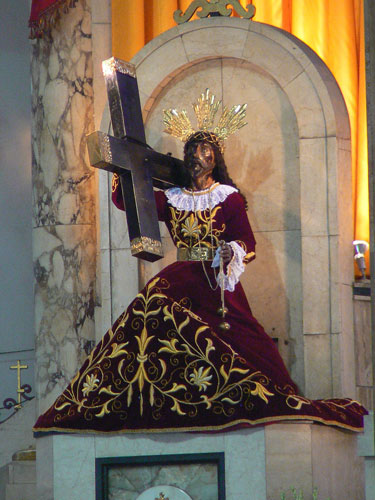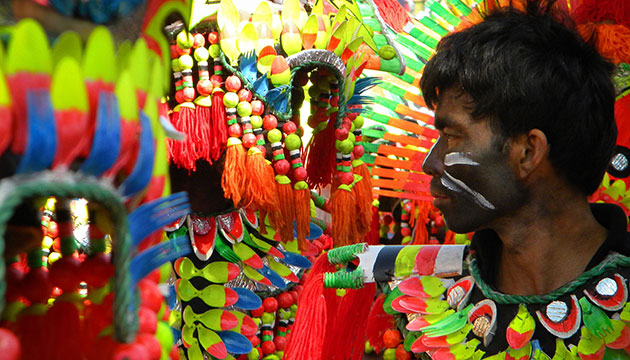Smoke from the last firecrackers of New Year’s eve still lingers in the air when preparations for festivals and fiestas in the Philippines start getting underway. In Manila a 9-day novena to the Black Nazarene, enshrined in the Quiapo church in Manila, whose feast day is in early January actually starts on January 1st.
At the end of the novena, an important big religious event to honor Jesus Christ takes place. On January 9, the reenactment of "traslacion" or solemn transfer of the Black Nazarene from Intramuros to the Minor Basilica of the Black Nazarene in the Quiapo district of the City of Manila. The Black Nazarene is a life-sized image, carved from dark wood, of a dark skinned Jesus Christ kneeling and carrying the cross on his way to His crucifixion at the Golgotha mountain. The life-sized statue of Christ, is carried through town by barefooted men yelling, "Viva Señor,” while huge crowd, fervently believing in the statue’s miraculous power, tries to touch the statue. The statue, carved by an unknown Mexican, was bought by a priest in Mexico who brought it to Manila in 1606.

The traslacion of the Black Nazarene which is a popular object of devotion in the Philippines, is joined by hundreds of thousands of devotees who usually walk barefooted and jostle each other to come closer to the carriage carrying the Black Nazarene during a rowdy procession that usually lasts for 20 hours. There are testimonials regarding how miraculous the Black Nazarene is. This is why as the procession proceeds, men atop the carriage catch the handkerchiefs thrown by the devotees, use these to wipe the statue of Jesus and throw them back to the people who then will make use of these handkerchiefs for healing purposes. This process goes on throughout the entire rowdy procession around the streets of Manila’s commercial district.
The downside of this event is that several people, because of the sheer number of devotees during the arduous procession, get injured every year. However, this has not dampened the spirit and enthusiasm of the devotees. On the contrary, the number of devotees continues to increase throughout the years. This Black Nazarene procession has been going on for many years.
Philippines is the only Catholic country in Asia. The catholic faith is expressed in many ways such as the religious fiestas or festivals in January to honor the baby Jesus as well as the solemn event of remembering the adult Jesus’s grueling journey to His crucifixion. These religious events are much anticipated and celebrated by devotees with a lot of enthusiasm and fervor.
The three fiestas or festivals to honor the Santo Nino (Holy Infant Jesus) are the Dinagyang Festival in Iloilo, the Sinulog Festival in Cebu, and the Ati-atihan Festival in Aklan. These Three festivals are religious, cultural, and participatory. Devotees who are so inclined to participate usually do so with great enthusiasm. All three religious events feature a procession, street dancing, ati-atihan dancing and dance competitions. Dance groups from neighboring towns and cities participate to win cash prices awarded to the winners at the end of the day. Ati-atihan means "to become like aetas (an indigenous tribe in the Philippines).
The Dinagyang which means "merry making" 'is held on the 4th Sunday of January in Iloilo, one week after Sinulog and Ati-atihan. During the celebration, the participants dance and chant “Hala Bira, viva Senior Santo Nino" as an expression of their faith in Baby Jesus.
The Sinulog Festival in Cebu is held on the third Sunday of January. Sinulog which refers to the strong current of the Cebu River is a dance ritual to honor the miraculous image of the Santo Nino and reenacted in a dance ritual to the beat of the drums. It features a fluvial parade in the early morning of Saturday. During the parade, participants fervently chant "Pit Senior" which is a shortened version of the Cebuano phrase “sangpit sa seño” meaning to ask or plead to Señor Santo Niño for help.
The Aklan Ati-atihan festival which is held on the third Sunday of January is said to be the "mother" of festivals Dinagyang and Sinulog. It was originally a pagan festival adopted by the Spaniards to honor the Santo Nino. People claim that unless you have been to this event, then you have not truly experienced a Filipino fiesta.
Because of these festivals, January is considered a good time to visit the Philippines for tourists. The weather is perfect. It is still cool and the sun shines brightly every day. Typhoons don’t usually happen this time of year. Christmas lanterns and other decoration are still up because Christmas in the Philippines does not end officially until the Feast of the Three Kings on January 6th. Many balikbayan Filipinos who come home for the holiday season usually stay until January to enjoy the many fietas and festivals they can only experience in the Philippines where catholic faith and Filipino folklore combine to produce such unique festivities.


